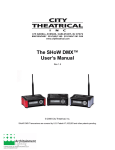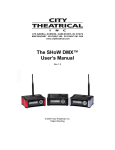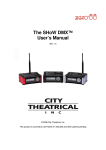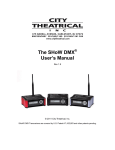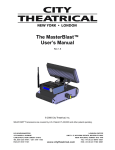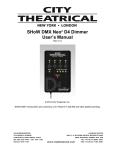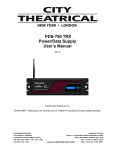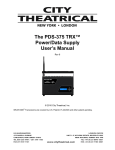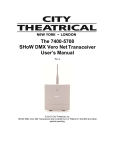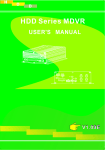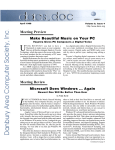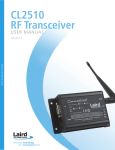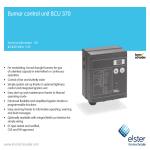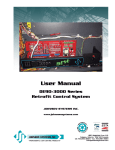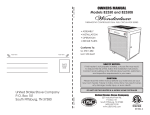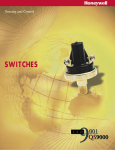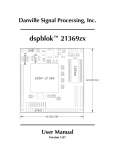Download The SHoW DMX™ OEM Receiver User`s Manual
Transcript
The SHoW DMX™ OEM Receiver User’s Manual Rev 1.2 © 2008 City Theatrical, Inc. Patent Pending The SHoW DMX OEM Receiver User’s Manual Contents Figures .............................................................................................................................. 3 Revision History ................................................................................................................ 3 Radio Compliance Information.......................................................................................... 4 5692 SHoW DMX Radio CE Declaration of Conformity ................................................ 7 System Compliance Information ....................................................................................... 8 Safety Notices ................................................................................................................... 8 End-Use Compliance Certifications .................................................................................. 8 Markings............................................................................................................................ 9 Installing the SHoW DMX OEM Receivers ..................................................................... 12 Typical Installation notes ............................................................................................. 12 Power requirements .................................................................................................... 12 Mounting Steps............................................................................................................ 13 Connections .................................................................................................................... 14 Hardware Configuration .................................................................................................. 14 Operating the SHoW DMX OEM Receiver...................................................................... 14 Controls and Features ................................................................................................. 15 Operation and Configuration ....................................................................................... 15 SHoW ID: ................................................................................................................ 16 Power ...................................................................................................................... 17 Software .................................................................................................................. 17 Certification ............................................................................................................. 17 Advanced OEM applications ........................................................................................... 17 Control and configuration via host user interface ........................................................ 17 Extension User Interface ............................................................................................. 18 DMX System Flow ....................................................................................................... 19 RDM System Flow....................................................................................................... 20 Frequency Hopping Spread Spectrum (FHSS) Radio Technology................................. 20 The Advanced Wireless DMX Broadcast Features of SHoW DMX ................................ 21 A Custom-Built Radio .................................................................................................. 21 Optimized High-Speed Wireless Data Transmission................................................... 21 DMX Synchronized Hopping ....................................................................................... 21 Refresh Rate Compensation ....................................................................................... 21 Adjustable Output Power............................................................................................. 22 Full Bandwidth Hopping............................................................................................... 22 Limited Bandwidth Hopping......................................................................................... 22 Limited Burst DMX Output........................................................................................... 22 Appendix A, SHoW DMX Model Summary ..................................................................... 24 Appendix B, SHoW DMX OEM Unit Part Numbers......................................................... 26 Remote User Interface Part Number Generation:........................................................... 26 Optional accessories not included with an OEM:............................................................ 26 Rev 1.1 10/14/08 2 of 27 Pages The SHoW DMX OEM Receiver User’s Manual Figures Figure 1, Required Label for 5691 Radio, 5605 Receiver, 5607 Transmitter.................... 9 Figure 2, required Label for 5692 Radio, 5606 Receiver, 5608 Transmitter ..................... 9 Figure 3, OEM Unit Specifications .................................................................................. 11 Figure 4, OEM Unit Dimensions and Mounting Holes..................................................... 11 Figure 5, SHoW DMX OEM Unit ..................................................................................... 12 Figure 6, SHoW DMX OEM Wiring ................................................................................. 13 Figure 7, the SHoW DMX OEM Receiver Controls......................................................... 15 Figure 8, the SHoW DMX OEM Receiver Menus ........................................................... 15 Figure 9, SHoW ID Table ................................................................................................ 17 Figure 10, OEM User Interface Extension Dimensions................................................... 18 Revision History R0.10 Initial Draft Release R0.11 Minor amendments R0.12 Clarify power settings, application notes R0.13 Add CE DoC R1.0 Correct DIP SS, release for production R1.1 Add OEM Extension PCB Information R1.2 Add Compliance clarification Rev 1.1 10/14/08 3 of 27 Pages The SHoW DMX OEM Receiver User’s Manual Radio Compliance Information City Theatrical, Inc. # 5691 SHoW DMX Radio Transceiver FCC ID: VU65691 IC ID: 7480A5691 City Theatrical, Inc. # 5692 SHoW DMX Radio Transceiver FCC ID: VU65692 IC ID: 7480A5692 CE mark: CE1177 FCC Part 15 This equipment has been tested and found to comply with the limits for a Class B digital device, pursuant to part 15 of the FCC Rules. These limits are designed to provide reasonable protection against harmful interference in a residential installation. This equipment generates, uses and can radiate radio frequency energy and, if not installed and used in accordance with the instructions, may cause harmful interference to radio communications. However, there is no guarantee that interference will not occur in a particular installation. If this equipment does cause harmful interference to radio or television reception, which can be determined by turning the equipment off and on, the user is encouraged to try to correct the interference by one or more of the following measures: • Reorient or relocate the receiving antenna. • Increase the separation between the equipment and receiver. • Connect the equipment into an outlet on a circuit different from that to which the receiver is connected. • Consult the dealer or an experienced radio/ TV technician for help. Radio Frequency Notifications FCC Notifications RF Radiation The Product is an intentional radiator of Radio Frequency (RF) energy. In order to limit RF exposure to personnel in the immediate area, the Product should be located and installed such that a separation of at least 20 centimeters is maintained between the Product’s antenna and personnel in the vicinity of the device. Modification Warning Caution: changes or modifications to this equipment, not expressly approved by City Theatrical Inc. could void the user’s authority to operate the equipment. Industry Canada Notifications This Class B digital apparatus complies with Canadian ICES-003. Operation is subject to the following two conditions: (1) this device may not cause interference, and (2) this device must accept any interference, including interference that may cause undesired operation of the device. Cet appareil numérique de la classe B est conforme à la norme NMB-003 du Canada. Product Installation and Configuration Guide © City Theatrical Inc. 2007 Approved Antenna To reduce potential radio interference to other users, the antenna type and its gain should be so chosen that the equivalent isotropically radiated power (e.i.r.p.) is not more than that permitted for successful communication. This device has been designed to operate with the antennas listed below, and having a Rev 1.1 10/14/08 4 of 27 Pages The SHoW DMX OEM Receiver User’s Manual maximum gain of 5 dB. Antennas not included in this list or having a gain greater than 5 dB are strictly prohibited for use with this device. The required antenna impedance is 50 ohms. Approved Antennas: Manufacturer Model Type Connector Gain 1 Nearson S151AH-2450S Omni whip SMA plug reverse polarity 5dBi 2 Nearson S141AH-2450 Omni whip SMA plug reverse polarity 2dBi 3 Centurion WCP2400-MMCX4 Omni whip MMCX jack on 4” coax pigtail 2.5dBi CE Mark Conformity City Theatrical Inc. declares that this product conforms to the specifications listed in this manual, following the provisions of the European R&TTE directive 1999/5/EC: City Theatrical Inc. vakuuttaa täten että dieses produkt tyyppinen laite on direktiivin 1999/5/EY oleellisten vaatimusten ja sitä koskevien näiden direktiivien muiden ehtojen mukainen. City Theatrical Inc. déclare que le produit est conforme aux conditions essentielles et aux dispositions relatives à la directive 1999/5/EC. • EN 301 489-1, 301 489-17 General EMC requirements for Radio equipment. • EN 60950 Safety • EN 300 328 Technical requirements for Radio equipment. CAUTION—This equipment is intended to be used in all EU and EFTA countries. Outdoor use may be restricted to certain frequencies and/or may require a license for operation. Contact local Authority for procedure to follow. Note: ESD precautions should be used when attaching or removing the antenna. Note: Combinations of power levels and antennas resulting in a radiated power level of above 100 mW equivalent isotropic radiated power (EIRP) are considered as not compliant with the above mentioned directive and are not allowed for use within the European community and countries that have adopted the European R&TTE directive 1999/5/EC. For more details on legal combinations of power levels and antennas, contact City Theatrical Inc. Do not use this product near water, for example, in a wet basement or near a swimming pool. Avoid using this product during an electrical storm. There may be a remote risk of electric shock from lightning. 72 Product Installation and Configuration Guide © City Theatrical Inc. 2007 Q52 Regulatory information Radio Frequency Notifications Belgique Dans le cas d'une utilisation privée, à l'extérieur d'un bâtiment, au-dessus d'un espace public, aucun enregistrement n'est nécessaire pour une distance de moins de 300m. Pour une distance supérieure à 300m un enregistrement auprès de l'IBPT est requise. Pour une utilisation publique à l'extérieur de bâtiments, une licence de l'IBPT est requise. Pour les Rev 1.1 10/14/08 5 of 27 Pages The SHoW DMX OEM Receiver User’s Manual enregistrements et licences, veuillez contacter l'IBPT. France 2.4 GHz Bande : les canaux 10, 11, 12, 13 (2457, 2462, 2467, et 2472 MHz respectivement) sont complétement libres d'utilisation en France (en utilisation intérieur). Pour ce qui est des autres canaux, ils peuvent être soumis à autorisation selon le départment. L'utilisation en extérieur est soumis à autorisation préalable et très restreint. Vous pouvez contacter l'Autorité de Régulation des Télécommunications (http://www.art-telecom.fr) pour de plus amples renseignements. Rev 1.1 10/14/08 6 of 27 Pages The SHoW DMX OEM Receiver User’s Manual 5692 SHoW DMX Radio CE Declaration of Conformity Rev 1.1 10/14/08 7 of 27 Pages The SHoW DMX OEM Receiver User’s Manual System Compliance Information All SHoW DMX Products are RoHS Compliant Safety Notices Please read this entire manual before using your new equipment. Please keep the manual in a safe place so you can refer to it in the future as required. The SHoW DMX System is intended for use only by qualified professionals. Connection, installation and hanging of this equipment must be performed in accordance with all pertinent local, regional and national safety codes and regulations. SHoW DMX equipment is intended for indoor use only unless specified for outdoor use. Keep the equipment dry! Do not operate the equipment if it gets wet! Do not operate in excessive heat/direct sunlight. Be sure installation provides adequate ventilation. Some system components can produce significant heat and must be properly installed to allow proper cooling and assure user safety. All sides of the equipment must be clear of obstruction and allow free airflow. There are no user-serviceable parts inside! Refer to qualified service personnel! RF Exposure: The antenna(s) used for this transmitter must be installed to provide a separation distance of at least 20cm from all persons and must not be collocated or operating in conjunction with any other antenna or transmitter. End-Use Compliance Certifications City Theatrical # 5691 and 5692 Radios are fully compliant with the agency requirements indicated by their certification markings when used in OEM applications, and are approved for modular OEM use. City Theatrical, Inc. # 5605 OEM Receivers are designed to meet North American safety and emissions standards, however final compliance can only be confirmed after units are correctly installed in the host hardware. City Theatrical, Inc. # 5606 OEM Receivers are designed to meet North American and CE safety and emissions standards, however final compliance can only be confirmed after units are correctly installed in the host hardware. OEM Applications of these City Theatrical Inc. products are not to be considered compliant with agency requirements until the final OEM equipped products are tested and certified separately for the applicable requirements. End-use compliance testing and certification is the responsibility of the OEM user. Rev 1.1 10/14/08 8 of 27 Pages The SHoW DMX OEM Receiver User’s Manual Markings Radio compliance rules require that the following markings be placed on the final assembly that the OEM Receivers are installed in. These markings apply to the City Theatrical SHoW DMX Radio in this device Figure 1, Required Label for 5691 Radio, 5605 Receiver, 5607 Transmitter These markings apply to the City Theatrical SHoW DMX Radio in this device Figure 2, required Label for 5692 Radio, 5606 Receiver, 5608 Transmitter Rev 1.1 10/14/08 9 of 27 Pages The SHoW DMX OEM Receiver User’s Manual Introduction Thank you for selecting City Theatrical’s SHoW DMX System! The SHoW DMX System is an advanced 2.4Ghz Frequency Hopping Spread Spectrum (FHSS) wireless DMX and RDM distribution and low voltage lighting control system. SHoW DMX is intended to provide superior broadcast reliability and fidelity while offering a range of power and frequency hopping configurations designed to enhance system compatibility with other types of 2.4Ghz systems that may be negatively affected by conventional 2.4Ghz FHSS systems. In other words, SHoW DMX is meant to be a powerful and high fidelity but “low impact” wireless system with the best features of FHSS. Many of these “low impact” and improved fidelity features are patent pending. This manual is intended to provide the OEM user and installer with all the information needed to install and configure the SHoW DMX OEM Receiver. For detailed operating and application information for the rest of the SHoW DMX System, please also refer to the SHoW DMX System User’s Manual. The SHoW DMX System incorporates a number of new broadcast features to enhance radio data delivery and fidelity, including high speed broadcast data rate with optimized data format, DMX synchronized hopping, adjustable output power, full bandwidth hopping, and limited bandwidth hopping. Each of these features is discussed in detail in the SHoW DMX System User’s Manual. Every effort has been made to anticipate your questions in this manual, but if you have any questions that are not answered here, or you want to discuss a special application, please feel free to contact us directly at City Theatrical. The SHoW DMX System includes a wide range of products which you may review at our website (www.citytheatrical.com) or in our catalog. For basic wireless operation, a minimum of one SHoW DMX Transmitter and one SHoW DMX Receiver is required. Rev 1.1 10/14/08 10 of 27 Pages Unit Model # Dimensions Weight Power Req. Radio Broadcast Power Radio Certifications Ambient Operating Temp Range OEM Receiver 5605 2.25 x 2.75 x0.50 2 Oz. 5VDC or 9-24VDC, 2 Watts 5691 5mW - 125mW FCC FCC, IC 0 - 40º c OEM Receiver-CE 5606 2.25 x 2.75 x0.51 3 Oz. 5VDC or 9-24VDC, 2 Watts 5692 5mW - 100mW ETSI FCC, IC, CE 0 - 40º c OEM Transmitter 5607 2.25 x 2.75 x0.50 2 Oz. 5VDC or 9-24VDC, 2 Watts 5691 5mW - 125mW FCC FCC, IC 0 - 40º c OEM TransmitterCE 5608 2.25 x 2.75 x0.51 3 Oz. 5VDC or 9-24VDC, 2 Watts 5692 5mW - 100mW ETSI FCC, IC, CE 0 - 40º c Figure 3, OEM Unit Specifications SHoW DMX OEM UNIT PCBA, FRONT VIEW SHoW DMX OEM UNIT INSTALLATION SIDE VIEW SHoW DMX OEM UNIT MOUNTING HOLE PATTERN 0.656 Mounting Panel 0.437 OEM Assembly OEM PCBA 2.450 0.200 0.200 0.784 1.474 2.750 2.930 select hole size for 4-40 hardware. Actual hole size shall be determined by fastener type selected. 0.400 Figure 4, OEM Unit Dimensions and Mounting Holes 1.600 1.450 0.975 0.219 Recommended Clearance 0.350 0.000 0.000 2.250 Installing the SHoW DMX OEM Receivers SHoW DMX Transmitters and Receivers have identical footprints and mounting hole and fastener requirements. Typical Installation notes • It is recommended that the unit be installed in a fully enclosed space constructed of a suitable RF shielding material such as steel or aluminum, in order to provide adequate RF shielding for the unit. • Provide adequate clearance and ventilation for the unit. • The SHoW DMX OEM Receivers are normally intended to be mounted on an external wall or panel. The mounting hole pattern is provided in Figure 2. • Care should be taken to match the recommended clearance distance from the PCBA surface to the inside mounting surface, to assure proper position of the display, access to the control buttons, and sufficient clearance between the inside wall and components on the OEM Receiver. • The recommended mounting panel thickness is 0.0625” - 0.125”. • SHoW DMX OEM Receivers require antennas and should not be operated without the antenna connected, and should only be operated with approved antennas. A list of approved antennas is provided on page 4. Power requirements The OEM Receivers can either be powered with +5VDC regulated power or +7-36VDC unregulated power. The total power requirement is 2 Watts. • If you are powering the unit with 5VDC, you must set switch S3 position 6 to 5V (up). • If you are powering the unit with +7-36VDC, you must set switch S3 position 6 to HV (down). If the switch is set incorrectly to the 5V (up) position and you feed it higher voltage the unit will be damaged. SHoW DMX Radio SHoW DMX OEM PCB Right Button Display J4, DMX Output Left Button J5, +VDC Input S3 Position 6, Power Select Antenna Cable Figure 5, SHoW DMX OEM Unit The SHoW DMX OEM Receiver User’s Manual Mounting Steps Refer to the installation drawings in Figure 5 and the wiring diagram in Figure 6. 1. Determine the desired location and prepare the mounting surface, providing the necessary mounting holes shown. The OEM Receivers are provided with 3 mounting holes for 4-40/M3 mounting hardware, and should be mounted with spacers/standoffs to provide .219” minimum clearance between the PCB surface and the mounting surface. PCBAs may be mounted on any suitable hardware, including screws with standoffs, PEM Standoffs, PEM studs with standoffs, etc. 2. Mount the OEM Receiver. The 3 mounting screws pass through both the OEM logic card and the Radio, securing both at the same time. 3. Check and configure the power select switch S3-p6. 4. Connect the VDC Power and the DMX data cables. The DMX connector (J4) and VDC Power connectors are on the back of the PCBA. See Figure 6, below. 5. Connect the antenna cable. CAUTION: The antenna connector is fragile. Do not bend or twist! Push the connector straight on to connect, and pull it straight off to disconnect. The PCB mount antenna connector may break off the PCB if twisted or bent. 6. Check all connections. DO NOT CONNECT THE MAIN POWER SOURCE TO THE OEM RECEIVER UNTIL ALL CONNECTIONS AND S3-P6 SETTING HAVE BEEN MADE CORRECTLY! J4 Pin 3: DMX Data+ J4 Pin 2: DMX DataJ4 Pin 1: DMX Common J5 Pin 2: DC Common J5 Pin 1: +VDC Figure 6, SHoW DMX OEM Wiring Rev 1.1 10/14/08 13 of 27 Pages The SHoW DMX OEM Receiver User’s Manual Connections J3 – ICPS Programming port (not normally used by end-user) J4: DMX J4 Pin 1: J4 Pin 2: J4 Pin 3: DMX Common DMX –Data DMX +Data J5: +VDC Power Input J5 Pin 1: +5 or 9-24 VDC Input J5 Pin 2: DC Common Hardware Configuration The OEM Receivers are provided with a 6 position SMT DIP Switch S3 (see Figure 5). S3 positions 1-5 are factory configured and should not be changed. The OEM Receivers are provided with an onboard DC/DC regulated power supply that will accept any input voltage from +9VDC to +24VDC and generate the required 5VDC regulated supply voltage for the Unit. Set S3-p6 to 5V (Up) for +5VDC power, and set to HV (Down) for 9-24VDC power. As noted above, this switch must be correctly set to assure proper operation. Operating the SHoW DMX OEM Receiver Once installed and provided with appropriate power, the SHoW DMX OEM Receiver operates basically the same way that a standard SHoW DMX 5610 or 5611 Receiver works. A SHoW DMX Transmitter receives DMX or RDM data from a source and broadcasts it via radio waves. The radio signal is picked up by the OEM Receiver and converted back into wired DMX or RDM data. The OEM Receivers have all of the SHoW DMX RDM capability, including RDM Responder and RDM Proxy features, and may be controlled, configured and communicated with via RDM through the SHoW DMX RDM Monitor. Since the 5605/5606 OEM Receiver is configurable as a half duplex RDM Responder, it is capable of transmitting as well as receiving when used in the RDM mode. The CTI 5605 SHoW DMX OEM Receiver is the North American version and meets all North American (FCC and IC) radio requirements. The 5605 OEM Receiver’s maximum broadcast power output is 125mW FCC/395mW ETSI when equipped with the standard CTI 7” 5dBi Antenna. The 5606 SHoW DMX OEM Receiver is the international version and meets all North American and CE radio requirements. The 5606’s maximum broadcast power output is 32mW FCC/100mW ETSI when equipped with the standard CTI 7” 5dBi Antenna. All other controls and features are the same for both models. As noted in the compliance section on page 5, OEM Applications of these City Theatrical Inc. products are not to be considered compliant with agency requirements until the final Rev 1.1 10/14/08 14 of 27 Pages The SHoW DMX OEM Receiver User’s Manual OEM equipped products are tested and certified separately for the applicable requirements. End-use compliance testing and certification is the responsibility of the OEM user. Controls and Features Status LED Right Button Display Left Button Figure 7, the SHoW DMX OEM Receiver Controls The Display: Settings and unit information are shown in the LED Display. The Buttons: The left and right buttons are used to move through the menus and to adjust and select settings. The Status LED: The Status LED blinks Red to indicate operation and no Transmitter Detected, and blinks Green to indicate operation and Transmitter Detected. ID XX P XX SW CERT SHoW ID (1-64) Power Setting (5-125mW FCC or 5-100mW ETSI) Software versions (Unit Type, Radio) Radio Compliance Certifications (FCC/IC or FCC/IC/CE) Figure 8, the SHoW DMX OEM Receiver Menus Operation and Configuration Basic operation of the SHoW DMX OEM Receivers is simple. • The Display will timeout and turn off after 10 seconds if no buttons are pressed. If the display has turned off, press either button to turn it on. • Press the left button to move through the four menus. • Press the right button to activate a menu. Rev 1.1 10/14/08 15 of 27 Pages The SHoW DMX OEM Receiver User’s Manual • While in a menu: o press the right button to move forward through the menu options o press the left button to move back through the menu options o Press and hold the right button to scroll forward through the menu options o Press and hold the left button to select a menu option SHoW ID and Power are user selectable menus. SHoW ID: After power-up, the Status LED will blink and the LED display will read: ID xx (xx= SHoW ID). Whenever the OEM Receiver is powered up it will start in this menu. When you enter the menu (left button) the display will change to > xx. Scroll through the available choices and select the one you want (press and hold the left button). There are 64 SHoW IDs. Each corresponds to a different combination of Hopping Pattern and Broadcast Bandwidth settings. The SHoW IDs are defined in the table below: Show ID 1 2 3 4 5 6 7 8 9 10 11 12 13 14 15 16 17 18 19 20 21 22 23 24 25 26 Rev 1.1 10/14/08 Hopping Pattern 1 2 3 4 5 6 7 8 9 10 11 12 13 14 15 16 1 2 3 4 5 6 7 8 9 10 Bandwidth Full Full Full Full Full Full Full Full Full Full Full Full Full Full Full Full WiFi 1-6 WiFi 1-6 WiFi 1-6 WiFi 1-6 WiFi 1-6 WiFi 1-6 WiFi 1-6 WiFi 1-6 WiFi 1-6 WiFi 1-6 Show ID 33 34 35 36 37 38 39 40 41 42 43 44 45 46 47 48 49 50 51 52 53 54 55 56 57 58 16 of 27 Pages Hopping Pattern 1 2 3 4 5 6 7 8 9 10 11 12 13 14 15 16 1 2 3 4 5 6 7 8 9 10 Bandwidth WiFi 4-9 WiFi 4-9 WiFi 4-9 WiFi 4-9 WiFi 4-9 WiFi 4-9 WiFi 4-9 WiFi 4-9 WiFi 4-9 WiFi 4-9 WiFi 4-9 WiFi 4-9 WiFi 4-9 WiFi 4-9 WiFi 4-9 WiFi 4-9 WiFi 7-11 WiFi 7-11 WiFi 7-11 WiFi 7-11 WiFi 7-11 WiFi 7-11 WiFi 7-11 WiFi 7-11 WiFi 7-11 WiFi 7-11 The SHoW DMX OEM Receiver User’s Manual 27 28 29 30 31 32 11 12 13 14 15 16 WiFi 1-6 WiFi 1-6 WiFi 1-6 WiFi 1-6 WiFi 1-6 WiFi 1-6 59 60 61 62 63 64 11 12 13 14 15 16 WiFi 7-11 WiFi 7-11 WiFi 7-11 WiFi 7-11 WiFi 7-11 WiFi 7-11 Figure 9, SHoW ID Table The ShoW DMX System supports 16 different Frequency Hopping Spread Spectrum (FHSS) hopping patterns, full bandwidth broadcasting mode, and three different limited bandwidth broadcasting modes. The SHoW IDs allow the user to quickly select the desired combination of Hopping Pattern and Full or Limited Broadcast option that is desired. Please see The Advanced Wireless DMX Broadcast Features of SHoW DMX below for more about how these features can be used. Power The other user selectable option menu is Broadcast Power. Since the 5605/5606 OEM Receiver is configurable as a half duplex RDM Responder it is capable of transmitting as well as receiving when used in the RDM mode. Therefore, the OEM Receiver is provided with adjustable output power. For the 5605 OEM Receiver (North American) the available power settings are 5mW, 10mW, 50mW, 100mW, or 125mW FCC. For the 5606 OEM Receiver - CE, the power settings are 5mW, 10mW, 50mW or 100mW ETSI. When you page to the Power menu, the LED display will read: P xx (xx= power setting). When you enter the menu (left button) the display will change to > xx. Scroll through the available choices and select the one you want (press and hold the left button). Software This menu accesses the current software version in the OEM Receiver and in its SHoW DMX Radio. When you enter the menu (left button) the display will show the current software versions. This menu is not editable. Certification This menu accesses the compliance certifications of the OEM Receiver and its SHoW DMX Radio. When you enter the menu (left button) the display will show FCC, IC and CE compliance information. This menu is not editable. Advanced OEM applications The SHoW DMX OEM Receivers can be utilized in a number of ways other than the standard application. Control and configuration via host user interface The OEM Receiver can be controlled and configured directly from the host unit’s user interface via RDM commands. Please contact City Theatrical, Inc. for details. Rev 1.1 10/14/08 17 of 27 Pages The SHoW DMX OEM Receiver User’s Manual Extension User Interface The OEM unit can be provided with an optional User Interface PCBA (CTI # 5609) and cable. This allows positioning of the interface on a different surface or at a different angle than the OEM PCB assembly. In order to use this interface, you will need to have an OEM unit that is provided with the optional extension interface connector, which includes all models with part numbers ending in “R” or “D”. To connect the 5609 Extension UI to the OEM Unit, simply connect the UI’s provided flat cable to the mating connector on the OEM. The Extension UI can be used with an OEM without a local interface (e.g. 5605LR) or with an OEM Unit with a local interface (e.g. 5605LD). When using the 5609 Extension UI with an OEM unit that is already provided with a local interface, both interfaces will operate and the displays will mimic each other. select hole size for 4-40 hardware. Actual hole size shall be determined by fastener type selected. Figure 10, OEM User Interface Extension Dimensions Rev 1.1 10/14/08 18 of 27 Pages The SHoW DMX OEM Receiver User’s Manual The SHoW DMX System The SHoW DMX System is a complete wireless DMX/RDM lighting system, intended to provide everything needed for general wireless DMX/RDM distribution, wireless control and battery powered operation of lighting and stage effects, including costume and set lighting and effects control, or any other application where wireless DMX/RDM control and/or battery powered dimming or effects control might be needed. In addition to the powerful but gentle wireless DMX/RDM distribution that SHoW DMX provides, the SHoW DMX Three Channel 10A Dimmer serves as a versatile lighting control module, providing three channels of 9-24VDC incandescent ISL and Linear dimming, Non Dim control, and RGB LED control in a single feature-packed unit. The SHoW DMX System includes the 5600 and 5601 Transmitters, the 5610 and 5611 Receivers The 5605 and 5606 OEM Receivers, and the 5620 Three Channel 10A Dimmer. The 5600 Transmitter, 5610 Receiver, and 5605 OEM Receiver are designed for use in North America. The 5601 Transmitter, 5611 Receiver, 5606 OEM Receiver and 5620 Three Channel 10A Dimmer are certified for use in North America and also are CE certified for use in Europe. Setting up a SHoW DMX system is quite similar to setting up any DMX512 control system. The principal thing to remember is that the Transmitter and Receiver(s) replace DMX cable. DMX System Flow DMX 512 control data from any standard DMX 512 console is output to the SHoW DMX Transmitter, which converts that DMX data to a radio signal and broadcasts it to the SHoW DMX Receiver (or Receivers). The SHoW DMX Receiver takes the radio broadcast and converts it back into standard DMX 512 data, which can than be connected via standard cables to SHoW DMX 5620 Dimmers or any other DMX devices such as moving lights, effects, etc. A typical DMX system diagram is shown in the drawing below. WIRELESS DMX BROADCAST TRANSMITTER RECEIVER DMX 512 CONTROL CABLE DMX 512 CONTROL CABLE THREE CH. DIMMER LOAD 1 LOAD 2 LOAD 3 LIGHTING CONSOLE Rev 1.1 10/14/08 12 ~ 24V BATTERY 19 of 27 Pages The SHoW DMX OEM Receiver User’s Manual RDM System Flow The SHoW DMX system also functions as an RDM Proxy system, by passing RDM commands and replies back and forth between any connected RDM controllers and responders. As with DMX, the principal thing to remember about RDM function is that the Transmitter and Receiver(s) replace DMX cable. The main difference between DMX and RDM operation is that RDM is a two-way system and so both Transmitters and Receivers may need to function as wireless broadcasters or receivers of the RDM data. In RDM mode, the SHoW DMX Transmitter converts incoming RDM commands to a radio signal and broadcasts them to the SHoW DMX Receiver (or Receivers). The SHoW DMX Receiver takes the radio broadcast and converts it back into standard RDM data, then responds to it and/or passes it along to connected RDM responders, collects any reply data from the RDM Responders, then converts the RDM responses back to a radio signal which is broadcast back to the Transmitter. The Transmitter converts the radio signals from the receiver back to wired RDM and sends it back upstream to the RDM system manager, or may function as the RDM system manager itself. A typical RDM system diagram is shown in the drawing below. WIRELESS DMX BROADCAST WIRELESS RDM COMMAND ETHERNET CABLE TRANSMITTER RECEIVER PERSONAL COMPUTER for RDM MANAGER DMX 512 CONTROL CABLE DMX 512 CONTROL CABLE THREE CH. DIMMER LOAD 1 LOAD 2 LOAD 3 LIGHTING CONSOLE 12 ~ 24V BATTERY Frequency Hopping Spread Spectrum (FHSS) Radio Technology The SHoW DMX radio utilizes a Frequency Hopping Spread Spectrum broadcast format in the unlicensed 2.4Ghz Industrial Scientific and Medical (ISM) radio band. FHSS broadcast format is a highly reliable and robust radio broadcasting technology that utilizes the entire broadcast spectrum by rapidly hopping from channel to channel and broadcasting briefly on each one. The order that the radio follows to hop from channel to channel is called the hopping pattern, and transmitters and their receivers must be synchronized on the same hopping pattern in order to communicate. There are many channels available in the broadcast spectrum, so the radios can hop in many different patterns, and there is little chance that FHSS radios operating on different patterns will Rev 1.1 10/14/08 20 of 27 Pages The SHoW DMX OEM Receiver User’s Manual use the same channel at the same time. This means that different sets of transmitters and receivers can be assigned to different hopping patterns, and then can operate simultaneously in the same area without much risk of interference or cross-talk. Because conventional 2.4Ghz FHSS technology hops all over the 2.4Ghz spectrum, it can interfere with other radio signals in the spectrum that are not FHSS systems including 2.4Ghz WiFi systems. The SHoW DMX system starts with 2.4Ghz FHSS broadcast technology, and then improves on it with many new features to provide even better fidelity while reducing the system’s effect on other less robust systems (such as WiFi) that may be operating in the same frequency band. The Advanced Wireless DMX Broadcast Features of SHoW DMX A Custom-Built Radio City Theatrical realized the next generation of wireless DMX equipment needed to be custom-tailored to meet the specific requirements of a wireless DMX system, so we developed a purpose-built radio transceiver with many advanced features that is specifically designed just to broadcast and receive DMX/RDM data. These advanced features are explained in the paragraphs below. Optimized High-Speed Wireless Data Transmission The SHoW DMX Transceiver’s high-speed through-air data structure has been optimized for wireless DMX delivery so that the system is utilized as efficiently as possible. This allows the system to broadcast two complete copies of each DMX packet it receives. DMX Synchronized Hopping CTI’s proprietary system synchronizes the FHSS hopping period so that every DMX data packet is transmitted completely during a single hop. Further, each DMX data packet is re-broadcast completely on the subsequent hop, and all of this happens during the period that the next DMX packet is arriving at the Transmitter. Since each data packet is transmitted twice on different channels, the odds of a refresh being lost to local channel interference are significantly reduced. Refresh Rate Compensation Many conventional wireless DMX systems output DMX data from their receivers at a constant speed. This means that if the console refresh rate is slower than the wireless system refresh rate, the wireless system has to make extra copies of some of the DMX packets, while if the console is faster than the wireless system, the wireless system will lose packets. CTI’s SHoW DMX is so fast that no DMX packets need be discarded, and SHoW DMX also adjusts its output to mimic the refresh rate of consoles that run slower than full speed. This means that you get the DMX packets out of SHoW DMX that you put in, no more, no less. Rev 1.1 10/14/08 21 of 27 Pages The SHoW DMX OEM Receiver User’s Manual Adjustable Output Power Sometimes an application calls for the most available broadcast power, but most entertainment systems do not need the full power of the SHoW DMX Transmitter. In Fact, many Broadway shows have used CTI’s 10mW WDS Transmitters for their wireless DMX systems. The broadcast power of the CTI SHoW DMX Transmitter is adjustable1 to allow the user to calibrate the system’s broadcast power to match the requirements of the venue. This means that for very long range applications the Transmitter can be dialed up to the maximum level, while for places where more than one system is likely to be in used in relatively close proximity, or where SHoW DMX is being used in the same environment with other more vulnerable wireless systems (e. g. WiFi), a lower power setting can be used. Adjustable output power can be coupled with SHoW DMX’s other advanced features to provide the “greenest”, smallest radio footprint available in wireless DMX delivery, while also offering the highest possible fidelity and the robust, reliable performance of FHSS Technology. Full Bandwidth Hopping SHoW DMX offers more than one kind of user-selectable FHSS hopping mode. In full bandwidth hopping mode, the system will continuously hop across the full 2.4Ghz spectrum, providing the most robust and interference-immune delivery mode available. The system supports 16 different full bandwidth hopping patterns, which can be used at any power setting, allowing a number of separate systems to broadcast multiple DMX Universes in the same venue or setting. Limited Bandwidth Hopping In the Limited Bandwidth Hopping mode, the SHoW DMX system is assigned to one of three sub-bands of the full 2.4Ghz spectrum. Each sub-band occupies approximately 2/5s of the full band, with one sub-band positioned at the low end, one in the center, and one at the high end of the full spectrum. The three sub-bands overlap and each avoids some combination of WiFi channels. This will allow the SHoW DMX Transmitter to be set to broadcast in a different area of the spectrum than other equipment being used in the area, to minimize or eliminate interference with WiFi or other channel specific or limited bandwidth equipment. Whenever the Transmitter broadcast power is set to 125mW or below, the user can select Limited Bandwidth Hopping. While not as robust as full bandwidth hopping, limited bandwidth hopping still offers much of the protection of FHSS broadcasting while having a lower impact on other more fragile systems. Limited Burst DMX Output Limited Burst mode reduces the number of DMX channels and the amount of radio energy that is broadcast by the SHoW DMX Transmitter. If you don’t need all 512 DMX values and you need to control the radio energy in your system as much as possible, then you can use Limited Burst to target only the DMX channels you need, and reduce your radio footprint even further. 1 5600 FCC Transmitter = 15mW ETSI (5mW FCC) to 398mW ETSI (125mW FCC), 5601 International Transmitter = 5mW ETSI to 100mW ETSI Rev 1.1 10/14/08 22 of 27 Pages The SHoW DMX OEM Receiver User’s Manual In Limited Burst mode, the user may select any contiguous group of 32 or more DMX values in multiples of 32 values. These may be assigned to any starting address that will accommodate the burst. Rev 1.1 10/14/08 23 of 27 Pages The SHoW DMX OEM Receiver User’s Manual Appendix A, SHoW DMX Model Summary Model SHoW DMX TransmitterNA SHoW DMX TransmitterInt SHoW DMX OEM ReceiverNA SHoW DMX OEM Receiver -Int SHoW DMX OEM Transmitter NA SHoW DMX OEM Transmitter Int Model Number 5600 5601 5605 5606 5607 5608 Broadcast Power 5mW FCC 10mW FCC 50mW FCC 100mW FCC 125mW FCC 5mW ETSI 10mW ETSI 50mW ETSI 100mW ETSI 5mW ETSI 10mW ETSI 50mW ETSI 100mW ETSI 5mW FCC 10mW FCC 50mW FCC 100mW FCC 125mW FCC 5mW ETSI 10mW ETSI 50mW ETSI 100mW ETSI Full Bandwidth Limited Bandwidth WiFi 1-6 Limited Bandwidth WiFi 4-9 Limited Bandwidth WiFi 7-11 Full (512 Slots) Limited (30480 Slots) Full Bandwidth Limited Bandwidth WiFi 1-6 Limited Bandwidth WiFi 4-9 Limited Bandwidth WiFi 7-11 Full (512 Slots) Limited (30480 Slots) 5mW FCC 10mW FCC 50mW FCC 100mW FCC 125mW FCC Full Bandwidth Limited Bandwidth WiFi 1-6 Limited Bandwidth WiFi 4-9 Limited Bandwidth WiFi 7-11 Full (512 Slots) Limited (30480 Slots) Full Bandwidth Limited Bandwidth WiFi 1-6 Limited Bandwidth WiFi 4-9 Limited Bandwidth WiFi 7-11 Full Bandwidth Limited Bandwidth WiFi 1-6 Limited Bandwidth WiFi 4-9 Limited Bandwidth WiFi 7-11 Full Bandwidth Limited Bandwidth WiFi 1-6 Limited Bandwidth WiFi 4-9 Limited Bandwidth WiFi 7-11 Full (512 Slots) Limited (30480 Slots) Full (512 Slots) Limited (30480 Slots) Full (512 Slots) Limited (30480 Slots) Hopping Patterns 16 16 16 16 16 16 Radio Transceiver CTI 5691 CTI 5692 CTI 5691 CTI 5692 CTI 5691 CTI 5692 RF Sensitivity -90dBm -90dBm -90dBm -90dBm -90dBm -90dBm RDM Features RDM Monitor as embedded web server RDM Proxy RDM Responder RDM Monitor as embedded web server RDM Proxy RDM Responder RDM Proxy RDM Responder RDM Proxy RDM Responder RDM Proxy RDM Responder RDM Proxy RDM Responder Compliance Certifications FCC, IC FCC, IC, CE FCC, IC FCC, IC, CE FCC, IC FCC, IC, CE 9-24VDC 250mA 6.25”W x 2.375”H x 5.125”D 2 Lbs 9-24VDC 250mA 6.25”W x 2.375”H x 5.125”D 2 Lbs 9-12VDC 250mA 9-12VDC 250mA 9-12VDC 250mA 9-12VDC 250mA 2" x 2.75" x .50" 2oz 2" x 2.75" x .50" 2oz 2" x 2.75" x .50" 2oz 2" x 2.75" x .50" 2oz Broadcast Modes DMX Burst Modes Power Dimensions Weight Rev 1.1 10/14/08 24 of 27 Pages The SHoW DMX OEM Receiver User’s Manual Model SHoW DMX Receiver-NA SHoW DMX Receiver-Int SHoW DMX Dimmer Model Number 5610 5611 5620 Broadcast Power 5mW FCC 10mW FCC 50mW FCC 100mW FCC 125mW FCC 5mW ETSI 10mW ETSI 50mW ETSI 100mW ETSI SHoW DMX Transceiver NA 5691 SHoW DMX Transceiver - Int 5692 n/a 5mW FCC 10mW FCC 50mW FCC 100mW FCC 125mW FCC 5mW FCC 10mW FCC 50mW FCC 100mW FCC Full Bandwidth Limited Bandwidth WiFi 16 Limited Bandwidth WiFi 49 Limited Bandwidth WiFi 711 Broadcast Modes Full Bandwidth Limited Bandwidth WiFi 1-6 Limited Bandwidth WiFi 4-9 Limited Bandwidth WiFi 7-11 Full Bandwidth Limited Bandwidth WiFi 1-6 Limited Bandwidth WiFi 4-9 Limited Bandwidth WiFi 7-11 n/a Full Bandwidth Limited Bandwidth WiFi 1-6 Limited Bandwidth WiFi 4-9 Limited Bandwidth WiFi 7-11 DMX Burst Modes Full (512 Slots) Limited (30-480 Slots) Full (512 Slots) Limited (30-480 Slots) n/a Full (512 Slots) Limited (30480 Slots) Full (512 Slots) Limited (30-480 Slots) Hopping Patterns 16 16 n/a 16 16 Radio Transceiver CTI 5691 CTI 5692 n/a n/a n/a RF Sensitivity -90dBm -90dBm n/a -90dBm -90dBm RDM Features RDM Proxy RDM Responder RDM Proxy RDM Responder RDM Responder n/a n/a Compliance Certifications FCC, IC, ETL Listed FCC, IC, CE, ETL Listed FCC Emissions, CE, ETL Listed FCC, IC FCC, IC, CE Power 9-24VDC 250mA, 100-240VAC 50/60Hz 3W 9-24VDC 250mA, 100-240VAC 50/60Hz 3W 9-24VDC 30A Max n/a n/a 6.25”W x 2.375”H x 5.125”D 2 Lbs 6.25”W x 2.375”H x 5.125”D 2 Lbs 1.62" x 2.75" x .25 1.62" x 2.75" x .26 1oz 1oz Dimensions Weight Rev 1.1 10/14/08 6.25”W x 2.375”H x 5.125”D 2 Lbs 25 of 27 Pages The SHoW DMX OEM Receiver User’s Manual Appendix B, SHoW DMX OEM Unit Part Numbers 560 ______ Base (1) Mode ______ ______ (2) (3) Voltage In Interface (1) Mode (Required) 5 – Receiver NA 6 – Receiver CE 7 – Transmitter NA 8 – Transmitter CE (2) Input Voltage (Required) H – 5V or 7-36V (Standard; Voltage is switch selectable, and will ship with 7-36V selected) L – 5V Only (3) Interface Option (Required) (Blank) – No installed interface (for RDM configuration) L – Local Interface Only R – Remote User Interface Only D – Dual User Interface (Includes extension connection either for later expansion or parallel use) Notes: • • • All small quantity (less than 30) OEM Assemblies have a lead time of 1-2 weeks ARO All large quantity (30 or greater) OEM Assemblies have a lead time of 3-5 weeks ARO A Remote User Interface requires a CTI P/N 5609XX Remote User Interface Part Number Generation: 5609 Base ______ (1) Cable Length (1) Cable Length (Required) Standard Length: 06 – 6” (153mm) Optional Lengths (ALWAYS 2 weeks ARO lead-time and 10pc MOQ) 02 – 2” (51mm) 03 – 3” (76mm) 04 – 4” (102mm) 05 – 5” (127mm) 08 – 8” (203mm) 10 – 10” (254mm) 12 – 12” (305mm) Optional accessories not included with an OEM: CTI 5609XX – Remote User Interface (See Above) CTI 5631 – Coax Antenna Cable, 5” (127mm), MMCX(M) Plug to RPSMA(F) Bulkhead Jack Rev 1.1 10/14/08 26 of 27 Pages The SHoW DMX OEM Receiver User’s Manual CTI 5630 – Omni Directional Swivel Antenna, 7” (178mm), 5dBi Gain, RPSMA(M) Connector CTI 5638 – Antenna Adapter Cable, RPSMA(M) to N(M), 12” (305mm) Length CTI 5632 – Maxrad MP24008XFPT, 8dBi Directional Panel Antenna (N(F) Connector) CTI 5634 – Maxrad MYP24010PT, 10dBi Directional Yagi Antenna (N(F) Connector), 12” (305mm) Tail CTI 5636 – Maxrad MYP24014PT, 14dBi Directional Yagi Antenna (N(F) Connector), 36” (0.91m) Tail CTI 5637 – Antenna Splitter/Combiner, 3x N(F) Connectors CTI 5639 – Gender Changer, N(M) to N(M) Rev 1.1 10/14/08 27 of 27 Pages



























